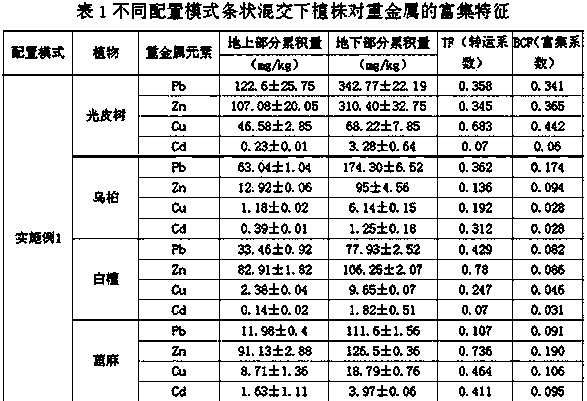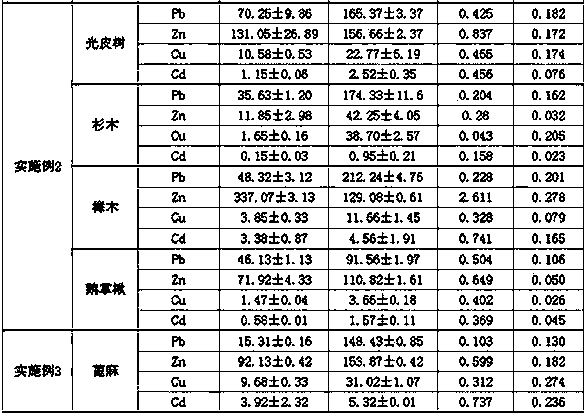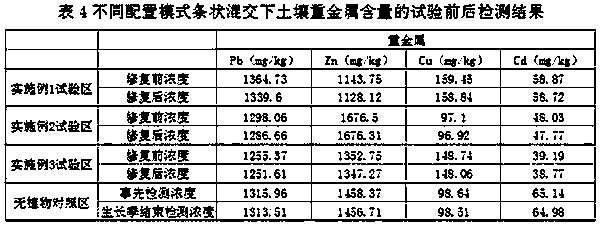Method for remedying heavy metal contaminated soil by energy plant configuration mode
A technology for energy plants and polluted soils, which is applied in the field of remediation of heavy metal polluted soil by using energy plant configuration mode, can solve the problems of long screening and cultivation period, small biomass of hyperaccumulator plants, and difficulty in multiple pollutants, so as to achieve no biological Invasion risk, increased plant diversity, good effect of heavy metal diffusion
- Summary
- Abstract
- Description
- Claims
- Application Information
AI Technical Summary
Problems solved by technology
Method used
Image
Examples
Embodiment 1
[0033] Example 1: Mixed planting pattern of trees, shrubs and grasses of oil plants: trees (sapium glabra, Chinese tallow) - shrubs (white sandalwood) - herbs (castor bean)
[0034] The plants have deep root systems, low environmental requirements, can overwinter in the south, are perennial plants, and are ideal heavy metal restoration plants. Photobark tree, white sandalwood, Chinese tallow, and castor are important energy plants. Their fruits have high oil content and are important industrial raw materials. They can produce high-quality and low-pollution fuels with properties similar to those of diesel and gasoline.
Embodiment 2
[0035] Example 2: Mixed planting mode of timber forest: balsa - Liriodendron - Chinese fir - beech
[0036] The plant has a large wood accumulation and biomass per unit area, is a reliable guarantee for the development of the processing industry and an important wood supply tree species, and has high economic value. Compared with the other three plants, beech has higher requirements on soil, but the mixed companion tree species are beneficial to the growth of beech. In addition to processing fruit oil into biodiesel or edible oil, the balsa tree is also a high-quality timber tree species. Its wood is fine and uniform, with straight texture and hard. It can be used for construction furniture, sculpture, agricultural tools and plywood. Can coexist friendly with other trees. In addition, beech, tulip tree, and light bark tree are also good landscape plants, which can beautify the environment while restoring the ecological environment.
Embodiment 3
[0037] Embodiment 3: single kind of pattern: interplanting of different castor-oil cultivars
[0038] Castor has the characteristics of drought resistance, barren resistance, and salt-alkali tolerance, and can tolerate 400-600mg / kg cadmium and 1000-2000mg / kg zinc polluted soil. At the same time, it is an important industrial oil plant, especially the raw material of fine chemical industry. The oil content of castor bean is 46% to 65%, and the oil content of the seed kernel is as high as about 70%. The yield per mu of castor beans is about 200-250kg, the stalk is 3000-4000kg, and the dry weight is about 750kg. Castor beans can be extracted for oil, and their fibrous stalks are used in building materials, papermaking, etc.
[0039] After the growing season, plant samples were taken and divided into roots, stems, leaves, and fruits, and dried to constant weight. The rhizosphere soil sub-test area was sampled and tested as the final value of soil analysis. Soil samples with HN...
PUM
 Login to View More
Login to View More Abstract
Description
Claims
Application Information
 Login to View More
Login to View More - R&D
- Intellectual Property
- Life Sciences
- Materials
- Tech Scout
- Unparalleled Data Quality
- Higher Quality Content
- 60% Fewer Hallucinations
Browse by: Latest US Patents, China's latest patents, Technical Efficacy Thesaurus, Application Domain, Technology Topic, Popular Technical Reports.
© 2025 PatSnap. All rights reserved.Legal|Privacy policy|Modern Slavery Act Transparency Statement|Sitemap|About US| Contact US: help@patsnap.com



